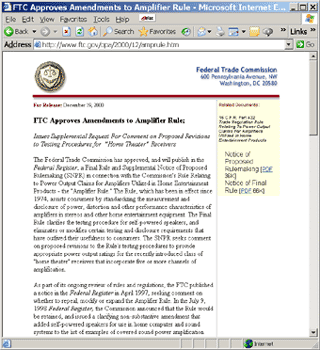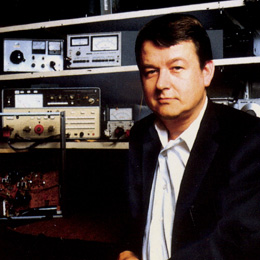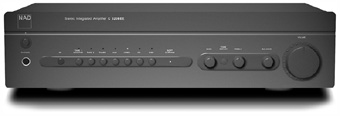![[SoundStage!]](../sslogo3.gif) Getting Technical Getting TechnicalBack-Issue Article |
March 2005 The Issue of the FTC's "Amplifier Rule" -- Part One
I decided to look into the matter, first to clarify what the actual FTC-amended rule states and then to interview industry leaders for their opinions. FTC’s "Amplifier Rule" In 1974, the Federal Trade Commission (FTC) brought forth the Rule Relating to Power Output Claims for Amplifiers Utilized in Home Entertainment Products -- the "Amplifier Rule." This rule standardized the measurement of power and how manufacturers were to disclose these measurements. No changes were made for almost 30 years until, under industry pressure, in 2000 the Amplifier Rule was amended. The FTC stated that the Final Rule "clarifies the testing procedure for self-powered speakers, and eliminates or modifies certain testing and disclosure requirements that have outlived their usefulness to consumers." Furthermore, the Final Rule will "provide appropriate power-output ratings for the recently introduced class of ‘home-theater’ receivers that incorporate five or more channels of amplification." The Final Rule adopted three amendments that were published in the Federal Register.
Manufacturers have had 30 years of Amplifier Rule compliance, and now these new amendments appear to have made the testing procedures more lax, which will likely benefit the makers of inferior electronics because it is costly to build the power supply and high-quality transistors needed to create amps with truly high power. For those who build amplifiers that can already meet the standards of the original Rule, there's no benefit whatsoever. So, at worst, manufacturers now have loopholes in the new Rule to claim higher power than is really achievable with their amplifier products, and at best most mass-market manufacturers may only produce amps that just pass the FTC's current regulations, which wouldn't have passed before. As a result, consumers aren't any better off. In fact, they're likely worse off. NAD’s "Full Disclosure Power Rating" One critic of the FTC’s revised Amplifier Rule is Mark Stone of NAD. For more than 30 years, NAD amplifiers have been known for delivering effective power. The company's 3020 integrated amp sold 1.5 million units -- according to NAD, more than any other integrated in history. Stone claims that the new regulation still allows manufacturers to specify equipment as more powerful than it really is. "How do you know the manufacturer’s specs reliably describe real power and real listening advantages?" asks Stone. "The biggest loophole is that the FTC does not specify the power supply used during measurements. Very poorly regulated or soft power supplies cause high voltages when driving an easy load, and a very low voltage when driving a complex load, such as loudspeakers. This little secret is the reason why for many products their power under all operating conditions is not fully disclosed. Many 100-watt receivers can only deliver a fraction of that when connected to a real loudspeaker and/or when all channels are driven." In response, NAD has created its Full Disclosure Power Rating, which Stone hopes will provide consumers with a broader understanding of the power-rating issue. "NAD uses a properly regulated, high-current power supply that is supplied in all NAD amplifiers and receivers," says Stone. "Thus we can rate our receivers with a difficult 4-ohm load, with all channels driven simultaneously, over the full frequency bandwidth (20Hz-20kHz), and at rated distortion. This is the Full Disclosure rating method on which all our amplifier and receiver specs are based, and it's a far cry from the FTC's minimal requirement of using an 8-ohm load, any associated channel (no more than two channels), at an easy 1kHz frequency, with no distortion specified." NAD also specifies the dynamic power at 8, 4, and 2 ohms to provide consumers with an even more realistic picture of their products’ performance. To play music or movies, loudspeakers need short bursts of very high power, or dynamic power, not necessarily continuous power. Bjorn Erik Edvardsen and NAD’s newest amplifier designs
NAD’s PowerDrive is the latest circuit designed by Bjorn Erik Edvardsen, NAD’s director of advanced development, who has been designing amps at NAD for nearly 30 years. Even three decades ago Edvardsen recognized that amplifiers designed with sine waves and load resistors, with a goal of low noise and distortion when driving just an 8-ohms resistive load, could measure well in the lab but then produce dreadful sound when playing actual music. Thus began his study of the differences between measured performance and perceived sound quality. Continuous power and steady-state distortion were not enough to create a powerful amp. Amplifier stability, low-impedance drive capability, and dynamic power were considered far more important. "The real question was how much power an amplifier could actually deliver into a real loudspeaker, and what was the distortion when playing music, as opposed to test signals. This led Erik down a different path that resulted in several very innovative design solutions," says Stone. "Erik’s latest design is the C320BEE in the hot category of high-performance budget integrated amplifiers. Compared to the current C320, the C320BEE includes numerous improvements in these three areas: performance, features, and industrial design." The concept of PowerDrive technology is to make a power supply of a given size act as though it is much larger. High dynamic power and low-impedance drive capability are possible with a "smart" power supply that can optimize itself for high current or high voltage, depending on the specific condition of operation. The amp senses the speaker impedance by performing continuous scans, thereby allowing the PowerDrive circuit to regulate power. "This new circuitry requires less cooling, while maintaining the ability to handle complex-impedance loads as low as 2 ohms," says Stone. "By adding a second high-voltage rail to our well-regulated, high-current power supply, we get an overdrive that can nearly double the continuous-power rating on a short-term, dynamic-power basis. PowerDrive offers greater amplifier stability and low-impedance drive capability, resulting in less distortion when driving real speakers with real program material." Conclusion
Unfortunately for consumers, above average is what they should look for when comparing power ratings. Amplifiers that simply comply with the FTC's revised Amplifier Rule may not have the power one assumes. This is why those at NAD don't feel the FTC is doing enough. According to Mark Stone, "[The recent changes have] completely eliminated any consumer protection offered by the 1970s ruling. NAD is still rating their amplifiers in accordance with the 1970s rule and challenges the rest of the industry to comply." ...Alison Aulph To learn more about NAD Electronics, visit www.nadelectronics.com.
|
|
![[SoundStage!]](../sslogo3.gif) All Contents All ContentsCopyright © 2005 SoundStage! All Rights Reserved |
 One of the greatest
arguments in the audiophile world regards power-amplifier ratings. Even with the
FTC-amended regulations, people still debate whether comparisons between amps are accurate
and if specs are accurate. And such debates can be heated.
One of the greatest
arguments in the audiophile world regards power-amplifier ratings. Even with the
FTC-amended regulations, people still debate whether comparisons between amps are accurate
and if specs are accurate. And such debates can be heated. "To maximize this
real, useful power in daily listening, we've developed an amplifier circuit we call
PowerDrive," explains Stone.
"To maximize this
real, useful power in daily listening, we've developed an amplifier circuit we call
PowerDrive," explains Stone.  "NAD
amplifiers sound powerful because they are indeed powerful," concludes Stone.
"NAD has an enviable reputation for delivering amplifiers whose performance is
exceptional for the price being asked. The C320BEE, for example, sells for just $399. This
has always been achieved by applying a very high level of engineering expertise to a
sensible design brief. Beyond this, the skill, experience, and passion for music possessed
by the NAD design team have lifted many NAD designs above the average."
"NAD
amplifiers sound powerful because they are indeed powerful," concludes Stone.
"NAD has an enviable reputation for delivering amplifiers whose performance is
exceptional for the price being asked. The C320BEE, for example, sells for just $399. This
has always been achieved by applying a very high level of engineering expertise to a
sensible design brief. Beyond this, the skill, experience, and passion for music possessed
by the NAD design team have lifted many NAD designs above the average."